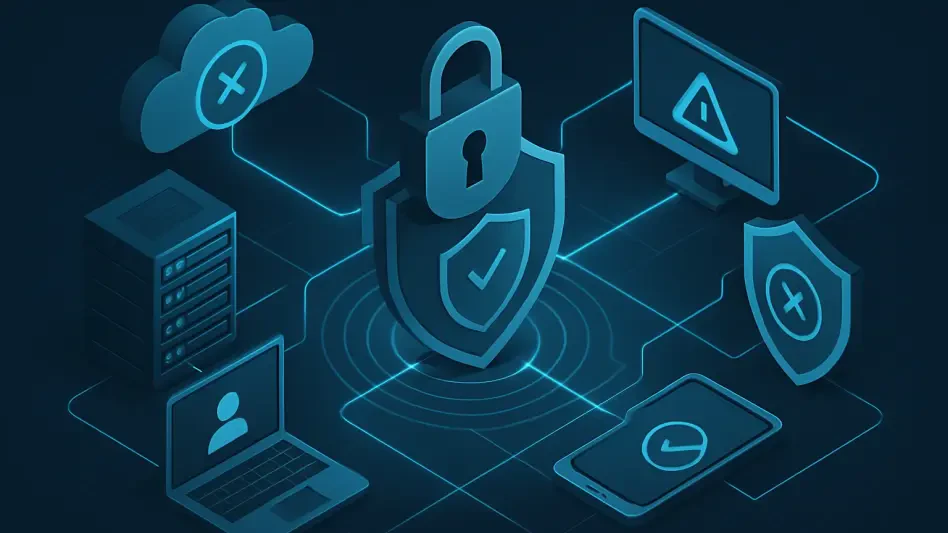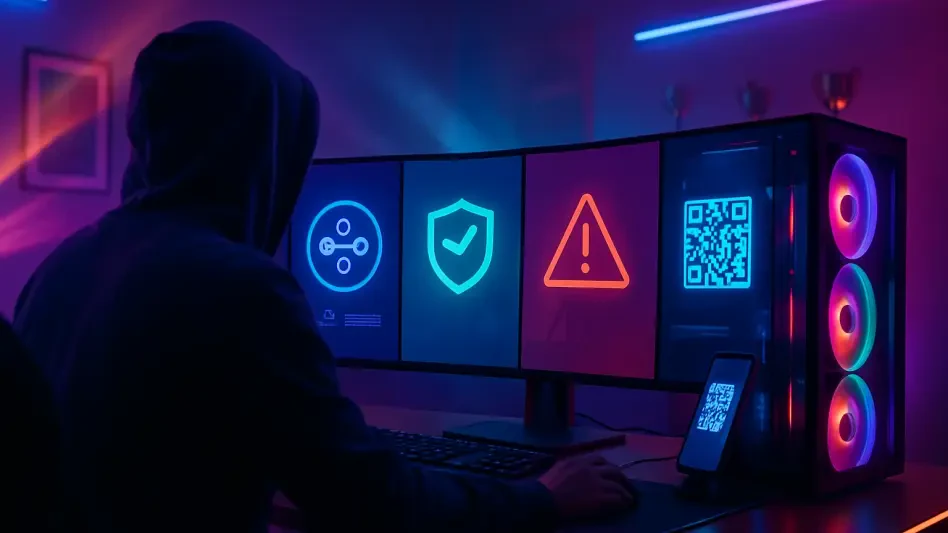Imagine a world where every digital interaction, from a simple email login to accessing critical infrastructure, is treated with the utmost suspicion until proven safe. This is the reality of cybersecurity today, where breaches have become not just a risk but a near certainty for many organizations, and with cyber-attacks increasing in sophistication, a staggering percentage of IT leaders report a sharp rise in threats over recent years. Traditional perimeter-based security models, once the gold standard, are crumbling under the pressure of distributed workforces and cloud environments. This review delves into zero-trust cybersecurity, a transformative approach that challenges the very notion of inherent trust in digital systems, promising a robust defense against an ever-evolving threat landscape.
The concept of zero-trust has emerged as a beacon of hope amid growing concerns over data breaches and unauthorized access. Unlike older models that assumed safety within a defined network boundary, this strategy operates on the principle of “never trust, always verify.” It has gained traction as businesses grapple with securing remote employees and hybrid IT setups. The urgency to adopt such a framework cannot be overstated, especially as attackers exploit vulnerabilities in outdated systems with alarming precision. This analysis aims to unpack the intricacies of zero-trust, evaluating its core components and real-world impact.
Diving Deep into Zero-Trust Features
Identity Verification and Access Control Mechanics
At the heart of zero-trust lies a rigorous focus on identity verification, ensuring that every user and device must prove legitimacy before gaining access to any resource. This foundational element rejects the outdated notion of implicit trust, instead requiring continuous authentication at every step. Technologies like multi-factor authentication (MFA) play a pivotal role, adding layers of security by demanding multiple forms of proof, such as passwords and biometric scans, before entry is granted. This approach significantly reduces the likelihood of unauthorized intrusions.
Beyond initial authentication, zero-trust employs ongoing monitoring to detect anomalies in user behavior or device activity. Such continuous scrutiny ensures that even if credentials are compromised, suspicious actions can be flagged and addressed promptly. The emphasis on strict access policies means that only verified entities interact with sensitive data, minimizing risks in environments where threats can originate from both external and internal sources. This feature stands out as a critical safeguard in modern cybersecurity.
Micro-Segmentation and Least Privilege Strategies
Another cornerstone of zero-trust is micro-segmentation, a technique that divides networks into smaller, isolated zones to prevent attackers from moving laterally across systems during a breach. By creating these tightly controlled segments, organizations can limit the scope of damage if a single point is compromised. This method contrasts sharply with traditional flat networks, where a breach in one area could grant access to an entire system, amplifying the potential for harm.
Complementing this is the principle of least privilege, which restricts access rights to the bare minimum necessary for a user’s role. Employees or devices are granted permissions only for specific tasks, ensuring that even if credentials are stolen, the attacker’s reach remains limited. Together, these strategies shrink the attack surface and contain threats effectively, offering a granular level of control that is essential for securing complex IT landscapes.
Performance and Adoption in the Real World
Trends Fueling Zero-Trust Integration
The adoption of zero-trust has accelerated due to several pressing trends in the digital ecosystem. The shift to remote work, coupled with widespread reliance on cloud computing, has dismantled the concept of a fixed network perimeter, making traditional defenses obsolete. Hybrid IT environments, blending on-premises and cloud resources, further complicate security, necessitating a model that verifies every access request regardless of location or origin. These dynamics have positioned zero-trust as a non-negotiable solution for many enterprises.
Technological advancements are also driving implementation forward. Innovations such as AI-driven threat detection enable real-time identification of risks, while automated policy enforcement streamlines the application of security rules across diverse systems. IT leaders increasingly recognize zero-trust as indispensable for countering sophisticated attacks, with many prioritizing its integration to stay ahead of evolving dangers. This momentum reflects a broader industry shift toward proactive and adaptive security measures.
Practical Applications Across Industries
Zero-trust has proven its worth across various sectors, with finance, healthcare, and government entities leveraging it to protect sensitive information and critical infrastructure. In finance, institutions use this framework to secure transactions and customer data against fraud, while healthcare organizations safeguard patient records in compliance with stringent regulations. Government agencies, often prime targets for cyber espionage, rely on zero-trust to defend national security assets from persistent threats.
Specific use cases highlight its versatility, such as securing remote workforces by ensuring that employees accessing systems from various locations are continuously verified. Similarly, cloud-based applications, now central to business operations, benefit from zero-trust policies that prevent unauthorized access to shared resources. Leading organizations have reported measurable outcomes, including significant reductions in breach incidents, demonstrating the tangible value of this approach in high-stakes environments.
Challenges in Deployment and Scalability
Technical and Organizational Barriers
Implementing zero-trust is not without hurdles, particularly when integrating it with legacy systems that were not designed for such a model. Many older infrastructures lack the flexibility to support continuous verification or micro-segmentation, requiring substantial overhauls or costly upgrades. Managing complex IT environments, where resources span multiple platforms and locations, adds another layer of difficulty, often demanding specialized expertise to ensure seamless operation.
Beyond technical issues, organizational resistance poses a significant challenge. Shifting to a zero-trust mindset requires a cultural change, as employees and stakeholders must adapt to stricter access controls and constant monitoring. Comprehensive staff training becomes essential to bridge knowledge gaps and foster acceptance, yet it can be resource-intensive. These barriers often slow down deployment, especially for entities unprepared for such a paradigm shift.
Addressing Cost and Accessibility Concerns
For smaller enterprises, the cost of adopting zero-trust can be prohibitive, as it often involves investing in new tools, infrastructure, and skilled personnel. Scalability remains a concern, with some organizations struggling to apply zero-trust principles across growing networks without compromising efficiency. These financial and logistical constraints highlight the need for accessible solutions tailored to diverse business sizes and budgets.
Efforts are underway to simplify implementation, with vendors developing more user-friendly platforms and offering modular approaches that allow gradual adoption. Industry initiatives also aim to lower entry barriers by providing frameworks and best practices that reduce complexity. While challenges persist, these advancements signal a move toward making zero-trust a viable option for a broader range of organizations in the near future.
Final Verdict on Zero-Trust Cybersecurity
Reflecting on this evaluation, zero-trust cybersecurity stands as a formidable response to the escalating cyber threats that plague organizations across sectors. Its core features, from relentless identity verification to meticulous micro-segmentation, deliver a robust defense mechanism that outshines traditional models. Despite the hurdles of integration and cost, the real-world benefits showcased in industries like finance and healthcare underscore its effectiveness in curbing breaches and securing distributed environments.
Looking ahead, the path forward demands a focus on innovation and accessibility. Organizations need to prioritize partnerships with technology providers to tailor zero-trust solutions to their unique needs, ensuring smoother transitions and scalability. Investing in employee education is critical to overcoming resistance and embedding a security-first culture. As the digital landscape continues to evolve, embracing zero-trust offers a strategic advantage, equipping businesses with the resilience to navigate future challenges with confidence.








